Report: Water Quality Issues Affecting Australian Cotton Production
VerifiedAdded on 2020/07/23
|14
|3682
|29
Report
AI Summary
This report analyzes the critical water quality issues impacting the Australian cotton production industry. It highlights the significance of water for maximizing crop yields and fiber quality, particularly in the face of climatic changes and increasing demands from various sectors. The report delves into the adverse effects of pesticides and agrochemicals, emphasizing their environmental consequences and impact on biodiversity, including contamination of water resources and harm to aquatic life. It identifies other quality issues like heavy metals and temperature changes, discussing their influence on aquatic ecosystems and biological parameters such as plankton. The report concludes by suggesting various measures to alleviate detrimental impacts on water quality, including the use of natural cleaning products, strict waste disposal regulations, efficient farming techniques, and effective water management strategies, underscoring the importance of ecosystem services for water quality and biodiversity.
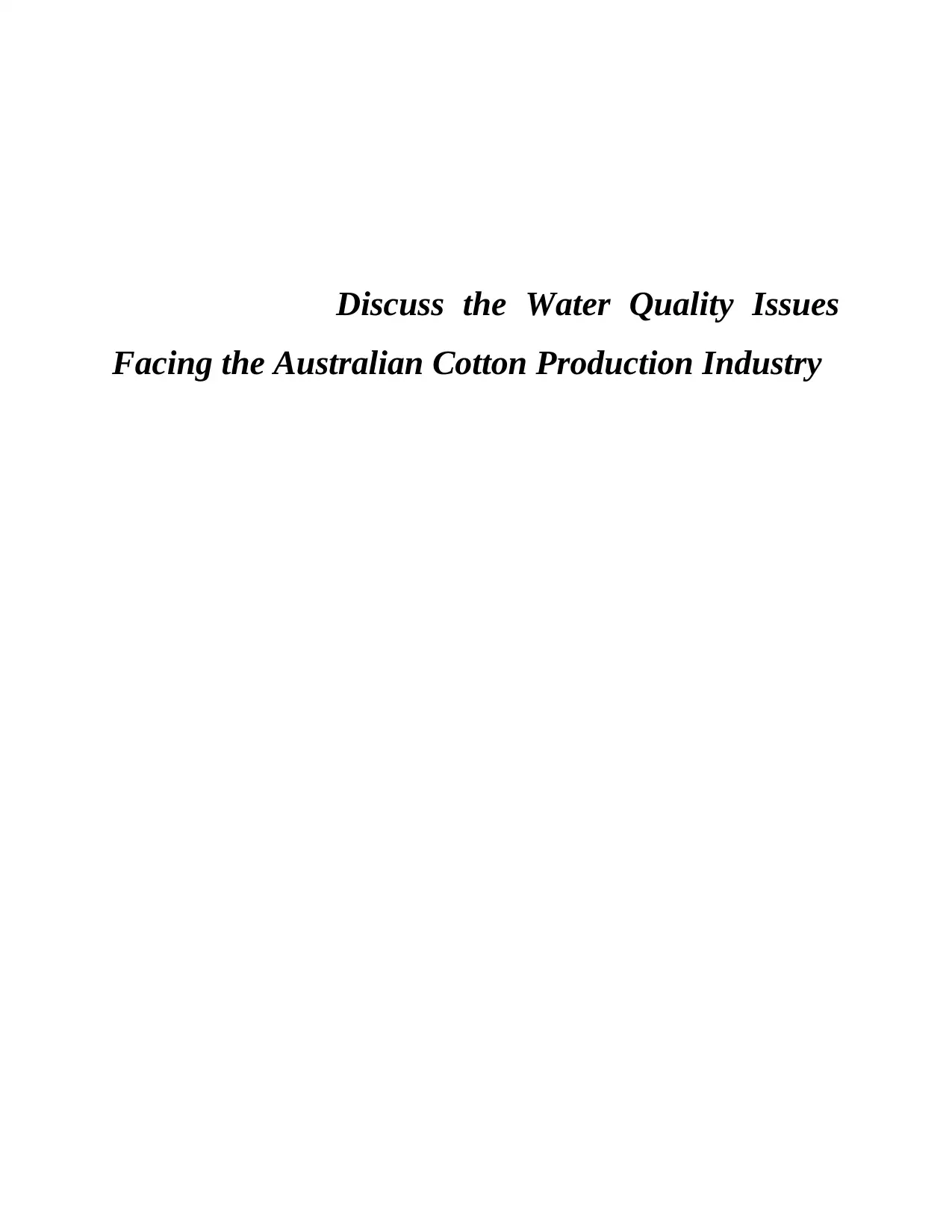
Discuss the Water Quality Issues
Facing the Australian Cotton Production Industry
Facing the Australian Cotton Production Industry
Paraphrase This Document
Need a fresh take? Get an instant paraphrase of this document with our AI Paraphraser

TABLE OF CONTENTS
INTRODUCTION...........................................................................................................................1
MAIN Body.....................................................................................................................................1
CONCLUSION................................................................................................................................8
REFERENCES................................................................................................................................9
INTRODUCTION...........................................................................................................................1
MAIN Body.....................................................................................................................................1
CONCLUSION................................................................................................................................8
REFERENCES................................................................................................................................9
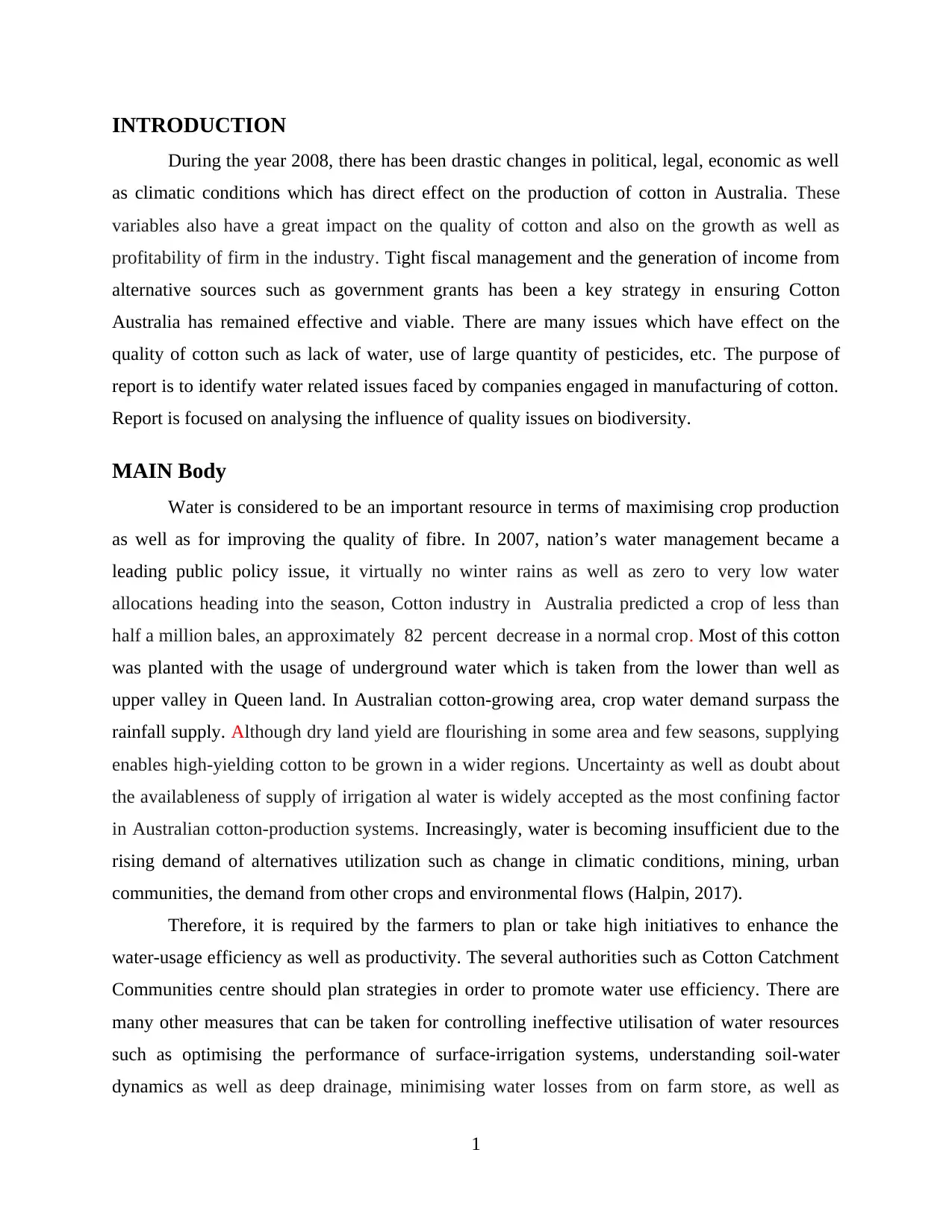
INTRODUCTION
During the year 2008, there has been drastic changes in political, legal, economic as well
as climatic conditions which has direct effect on the production of cotton in Australia. These
variables also have a great impact on the quality of cotton and also on the growth as well as
profitability of firm in the industry. Tight fiscal management and the generation of income from
alternative sources such as government grants has been a key strategy in ensuring Cotton
Australia has remained effective and viable. There are many issues which have effect on the
quality of cotton such as lack of water, use of large quantity of pesticides, etc. The purpose of
report is to identify water related issues faced by companies engaged in manufacturing of cotton.
Report is focused on analysing the influence of quality issues on biodiversity.
MAIN Body
Water is considered to be an important resource in terms of maximising crop production
as well as for improving the quality of fibre. In 2007, nation’s water management became a
leading public policy issue, it virtually no winter rains as well as zero to very low water
allocations heading into the season, Cotton industry in Australia predicted a crop of less than
half a million bales, an approximately 82 percent decrease in a normal crop. Most of this cotton
was planted with the usage of underground water which is taken from the lower than well as
upper valley in Queen land. In Australian cotton-growing area, crop water demand surpass the
rainfall supply. Although dry land yield are flourishing in some area and few seasons, supplying
enables high-yielding cotton to be grown in a wider regions. Uncertainty as well as doubt about
the availableness of supply of irrigation al water is widely accepted as the most confining factor
in Australian cotton-production systems. Increasingly, water is becoming insufficient due to the
rising demand of alternatives utilization such as change in climatic conditions, mining, urban
communities, the demand from other crops and environmental flows (Halpin, 2017).
Therefore, it is required by the farmers to plan or take high initiatives to enhance the
water-usage efficiency as well as productivity. The several authorities such as Cotton Catchment
Communities centre should plan strategies in order to promote water use efficiency. There are
many other measures that can be taken for controlling ineffective utilisation of water resources
such as optimising the performance of surface-irrigation systems, understanding soil-water
dynamics as well as deep drainage, minimising water losses from on farm store, as well as
1
During the year 2008, there has been drastic changes in political, legal, economic as well
as climatic conditions which has direct effect on the production of cotton in Australia. These
variables also have a great impact on the quality of cotton and also on the growth as well as
profitability of firm in the industry. Tight fiscal management and the generation of income from
alternative sources such as government grants has been a key strategy in ensuring Cotton
Australia has remained effective and viable. There are many issues which have effect on the
quality of cotton such as lack of water, use of large quantity of pesticides, etc. The purpose of
report is to identify water related issues faced by companies engaged in manufacturing of cotton.
Report is focused on analysing the influence of quality issues on biodiversity.
MAIN Body
Water is considered to be an important resource in terms of maximising crop production
as well as for improving the quality of fibre. In 2007, nation’s water management became a
leading public policy issue, it virtually no winter rains as well as zero to very low water
allocations heading into the season, Cotton industry in Australia predicted a crop of less than
half a million bales, an approximately 82 percent decrease in a normal crop. Most of this cotton
was planted with the usage of underground water which is taken from the lower than well as
upper valley in Queen land. In Australian cotton-growing area, crop water demand surpass the
rainfall supply. Although dry land yield are flourishing in some area and few seasons, supplying
enables high-yielding cotton to be grown in a wider regions. Uncertainty as well as doubt about
the availableness of supply of irrigation al water is widely accepted as the most confining factor
in Australian cotton-production systems. Increasingly, water is becoming insufficient due to the
rising demand of alternatives utilization such as change in climatic conditions, mining, urban
communities, the demand from other crops and environmental flows (Halpin, 2017).
Therefore, it is required by the farmers to plan or take high initiatives to enhance the
water-usage efficiency as well as productivity. The several authorities such as Cotton Catchment
Communities centre should plan strategies in order to promote water use efficiency. There are
many other measures that can be taken for controlling ineffective utilisation of water resources
such as optimising the performance of surface-irrigation systems, understanding soil-water
dynamics as well as deep drainage, minimising water losses from on farm store, as well as
1
⊘ This is a preview!⊘
Do you want full access?
Subscribe today to unlock all pages.

Trusted by 1+ million students worldwide

evaluating alternate irrigation systems to the conventional furrow-irrigation systems , evaluating
alternate irrigation systems to the conventional furrow-irrigation systems, developing the
understanding about the relationship between soil, water and plant.
2
alternate irrigation systems to the conventional furrow-irrigation systems, developing the
understanding about the relationship between soil, water and plant.
2
Paraphrase This Document
Need a fresh take? Get an instant paraphrase of this document with our AI Paraphraser
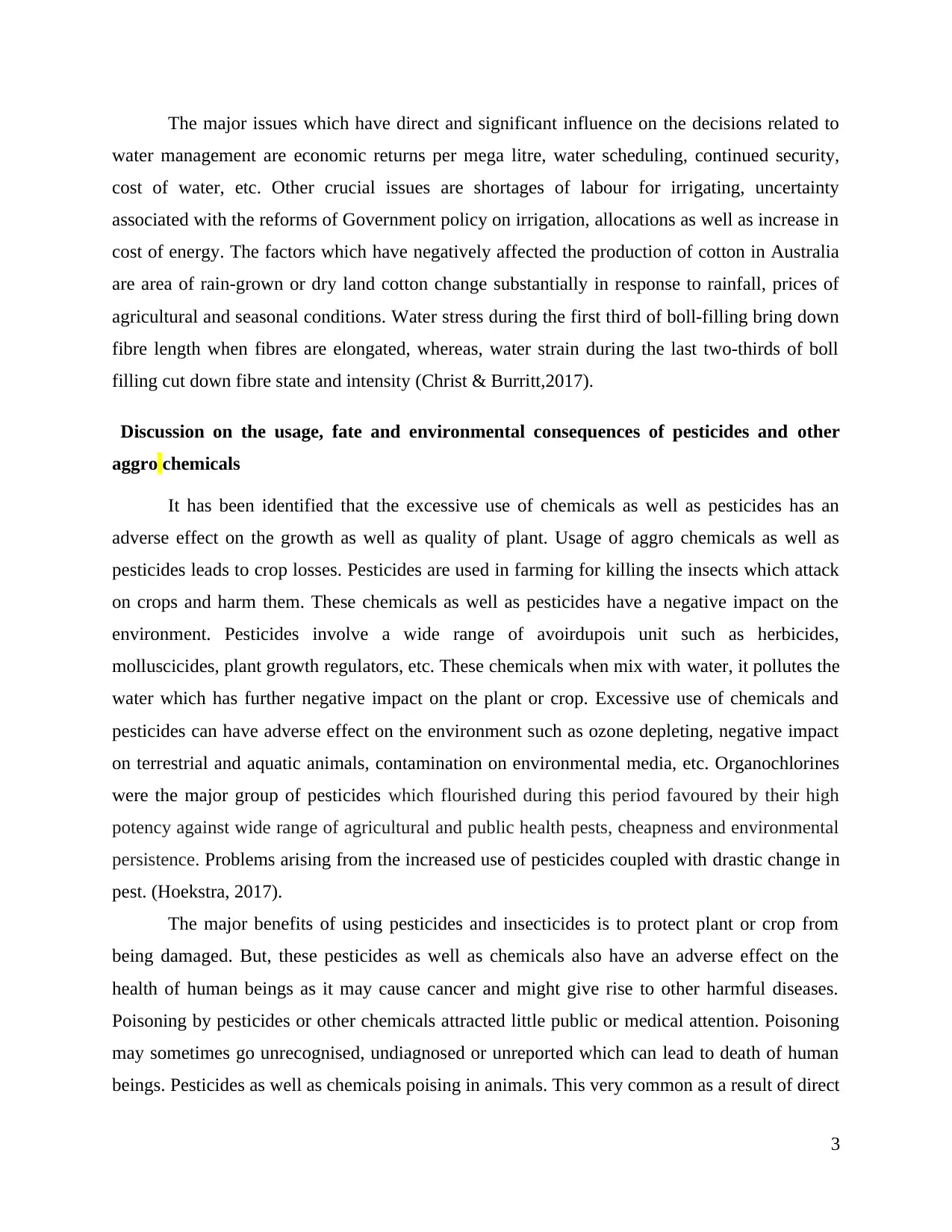
The major issues which have direct and significant influence on the decisions related to
water management are economic returns per mega litre, water scheduling, continued security,
cost of water, etc. Other crucial issues are shortages of labour for irrigating, uncertainty
associated with the reforms of Government policy on irrigation, allocations as well as increase in
cost of energy. The factors which have negatively affected the production of cotton in Australia
are area of rain-grown or dry land cotton change substantially in response to rainfall, prices of
agricultural and seasonal conditions. Water stress during the first third of boll-filling bring down
fibre length when fibres are elongated, whereas, water strain during the last two-thirds of boll
filling cut down fibre state and intensity (Christ & Burritt,2017).
Discussion on the usage, fate and environmental consequences of pesticides and other
aggro chemicals
It has been identified that the excessive use of chemicals as well as pesticides has an
adverse effect on the growth as well as quality of plant. Usage of aggro chemicals as well as
pesticides leads to crop losses. Pesticides are used in farming for killing the insects which attack
on crops and harm them. These chemicals as well as pesticides have a negative impact on the
environment. Pesticides involve a wide range of avoirdupois unit such as herbicides,
molluscicides, plant growth regulators, etc. These chemicals when mix with water, it pollutes the
water which has further negative impact on the plant or crop. Excessive use of chemicals and
pesticides can have adverse effect on the environment such as ozone depleting, negative impact
on terrestrial and aquatic animals, contamination on environmental media, etc. Organochlorines
were the major group of pesticides which flourished during this period favoured by their high
potency against wide range of agricultural and public health pests, cheapness and environmental
persistence. Problems arising from the increased use of pesticides coupled with drastic change in
pest. (Hoekstra, 2017).
The major benefits of using pesticides and insecticides is to protect plant or crop from
being damaged. But, these pesticides as well as chemicals also have an adverse effect on the
health of human beings as it may cause cancer and might give rise to other harmful diseases.
Poisoning by pesticides or other chemicals attracted little public or medical attention. Poisoning
may sometimes go unrecognised, undiagnosed or unreported which can lead to death of human
beings. Pesticides as well as chemicals poising in animals. This very common as a result of direct
3
water management are economic returns per mega litre, water scheduling, continued security,
cost of water, etc. Other crucial issues are shortages of labour for irrigating, uncertainty
associated with the reforms of Government policy on irrigation, allocations as well as increase in
cost of energy. The factors which have negatively affected the production of cotton in Australia
are area of rain-grown or dry land cotton change substantially in response to rainfall, prices of
agricultural and seasonal conditions. Water stress during the first third of boll-filling bring down
fibre length when fibres are elongated, whereas, water strain during the last two-thirds of boll
filling cut down fibre state and intensity (Christ & Burritt,2017).
Discussion on the usage, fate and environmental consequences of pesticides and other
aggro chemicals
It has been identified that the excessive use of chemicals as well as pesticides has an
adverse effect on the growth as well as quality of plant. Usage of aggro chemicals as well as
pesticides leads to crop losses. Pesticides are used in farming for killing the insects which attack
on crops and harm them. These chemicals as well as pesticides have a negative impact on the
environment. Pesticides involve a wide range of avoirdupois unit such as herbicides,
molluscicides, plant growth regulators, etc. These chemicals when mix with water, it pollutes the
water which has further negative impact on the plant or crop. Excessive use of chemicals and
pesticides can have adverse effect on the environment such as ozone depleting, negative impact
on terrestrial and aquatic animals, contamination on environmental media, etc. Organochlorines
were the major group of pesticides which flourished during this period favoured by their high
potency against wide range of agricultural and public health pests, cheapness and environmental
persistence. Problems arising from the increased use of pesticides coupled with drastic change in
pest. (Hoekstra, 2017).
The major benefits of using pesticides and insecticides is to protect plant or crop from
being damaged. But, these pesticides as well as chemicals also have an adverse effect on the
health of human beings as it may cause cancer and might give rise to other harmful diseases.
Poisoning by pesticides or other chemicals attracted little public or medical attention. Poisoning
may sometimes go unrecognised, undiagnosed or unreported which can lead to death of human
beings. Pesticides as well as chemicals poising in animals. This very common as a result of direct
3
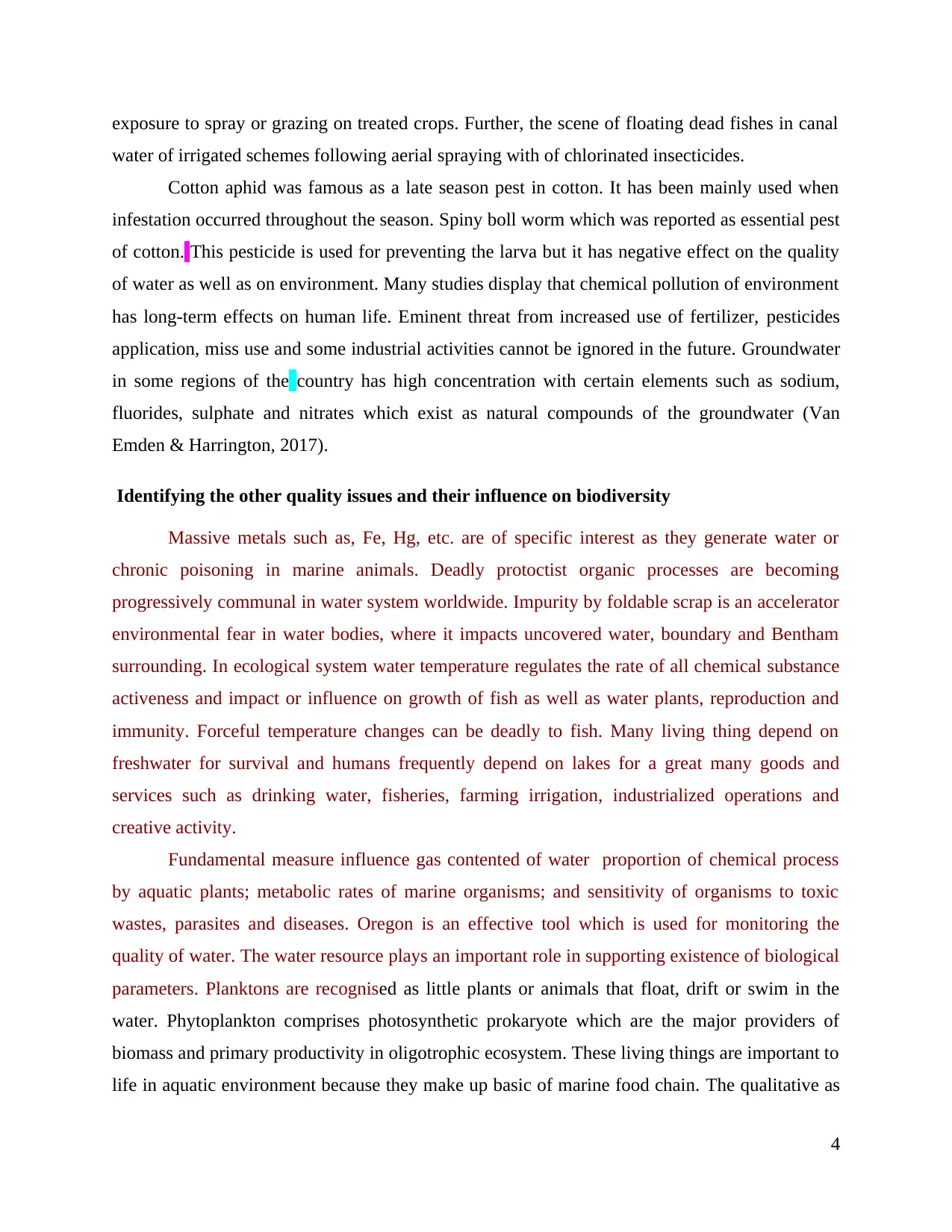
exposure to spray or grazing on treated crops. Further, the scene of floating dead fishes in canal
water of irrigated schemes following aerial spraying with of chlorinated insecticides.
Cotton aphid was famous as a late season pest in cotton. It has been mainly used when
infestation occurred throughout the season. Spiny boll worm which was reported as essential pest
of cotton. This pesticide is used for preventing the larva but it has negative effect on the quality
of water as well as on environment. Many studies display that chemical pollution of environment
has long-term effects on human life. Eminent threat from increased use of fertilizer, pesticides
application, miss use and some industrial activities cannot be ignored in the future. Groundwater
in some regions of the country has high concentration with certain elements such as sodium,
fluorides, sulphate and nitrates which exist as natural compounds of the groundwater (Van
Emden & Harrington, 2017).
Identifying the other quality issues and their influence on biodiversity
Massive metals such as, Fe, Hg, etc. are of specific interest as they generate water or
chronic poisoning in marine animals. Deadly protoctist organic processes are becoming
progressively communal in water system worldwide. Impurity by foldable scrap is an accelerator
environmental fear in water bodies, where it impacts uncovered water, boundary and Bentham
surrounding. In ecological system water temperature regulates the rate of all chemical substance
activeness and impact or influence on growth of fish as well as water plants, reproduction and
immunity. Forceful temperature changes can be deadly to fish. Many living thing depend on
freshwater for survival and humans frequently depend on lakes for a great many goods and
services such as drinking water, fisheries, farming irrigation, industrialized operations and
creative activity.
Fundamental measure influence gas contented of water proportion of chemical process
by aquatic plants; metabolic rates of marine organisms; and sensitivity of organisms to toxic
wastes, parasites and diseases. Oregon is an effective tool which is used for monitoring the
quality of water. The water resource plays an important role in supporting existence of biological
parameters. Planktons are recognised as little plants or animals that float, drift or swim in the
water. Phytoplankton comprises photosynthetic prokaryote which are the major providers of
biomass and primary productivity in oligotrophic ecosystem. These living things are important to
life in aquatic environment because they make up basic of marine food chain. The qualitative as
4
water of irrigated schemes following aerial spraying with of chlorinated insecticides.
Cotton aphid was famous as a late season pest in cotton. It has been mainly used when
infestation occurred throughout the season. Spiny boll worm which was reported as essential pest
of cotton. This pesticide is used for preventing the larva but it has negative effect on the quality
of water as well as on environment. Many studies display that chemical pollution of environment
has long-term effects on human life. Eminent threat from increased use of fertilizer, pesticides
application, miss use and some industrial activities cannot be ignored in the future. Groundwater
in some regions of the country has high concentration with certain elements such as sodium,
fluorides, sulphate and nitrates which exist as natural compounds of the groundwater (Van
Emden & Harrington, 2017).
Identifying the other quality issues and their influence on biodiversity
Massive metals such as, Fe, Hg, etc. are of specific interest as they generate water or
chronic poisoning in marine animals. Deadly protoctist organic processes are becoming
progressively communal in water system worldwide. Impurity by foldable scrap is an accelerator
environmental fear in water bodies, where it impacts uncovered water, boundary and Bentham
surrounding. In ecological system water temperature regulates the rate of all chemical substance
activeness and impact or influence on growth of fish as well as water plants, reproduction and
immunity. Forceful temperature changes can be deadly to fish. Many living thing depend on
freshwater for survival and humans frequently depend on lakes for a great many goods and
services such as drinking water, fisheries, farming irrigation, industrialized operations and
creative activity.
Fundamental measure influence gas contented of water proportion of chemical process
by aquatic plants; metabolic rates of marine organisms; and sensitivity of organisms to toxic
wastes, parasites and diseases. Oregon is an effective tool which is used for monitoring the
quality of water. The water resource plays an important role in supporting existence of biological
parameters. Planktons are recognised as little plants or animals that float, drift or swim in the
water. Phytoplankton comprises photosynthetic prokaryote which are the major providers of
biomass and primary productivity in oligotrophic ecosystem. These living things are important to
life in aquatic environment because they make up basic of marine food chain. The qualitative as
4
⊘ This is a preview!⊘
Do you want full access?
Subscribe today to unlock all pages.

Trusted by 1+ million students worldwide
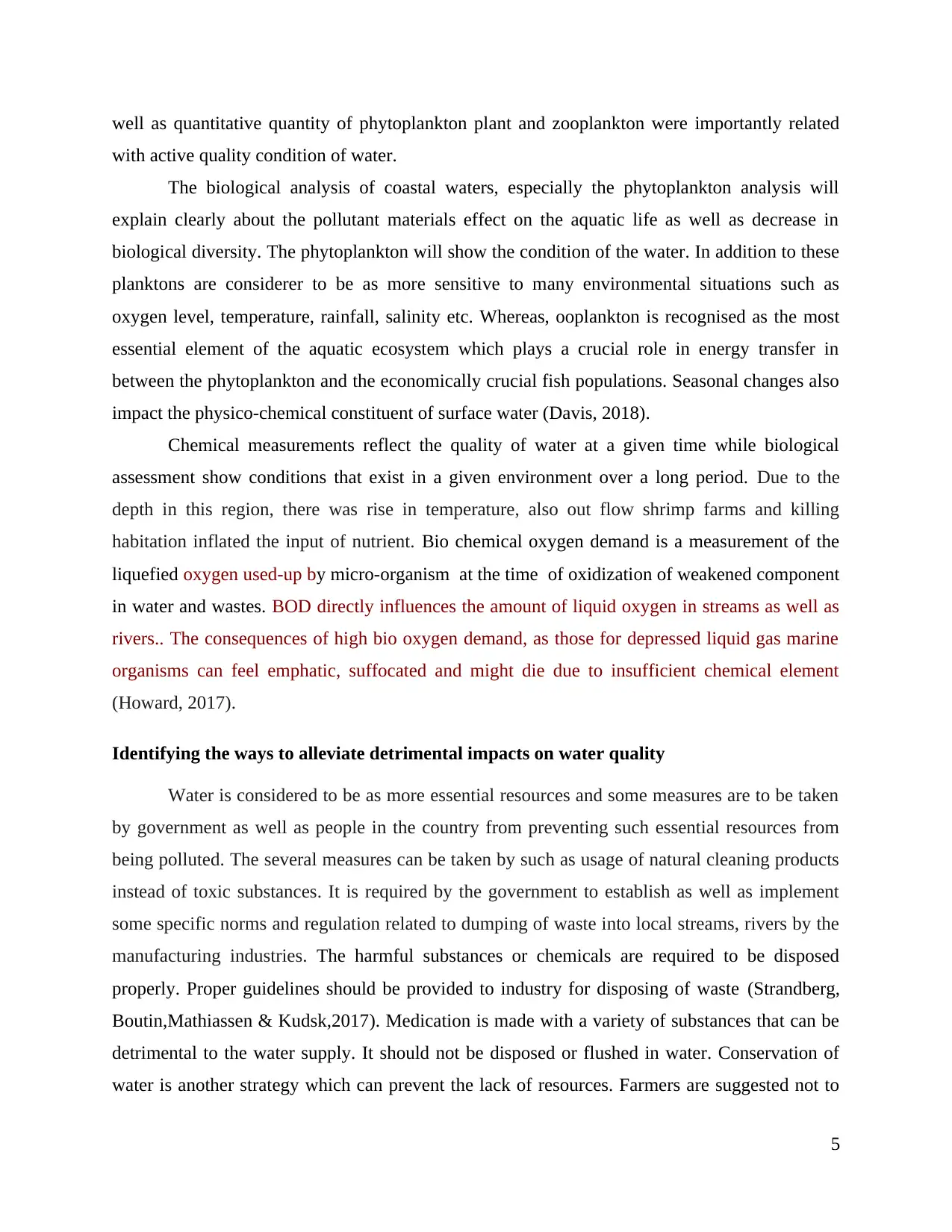
well as quantitative quantity of phytoplankton plant and zooplankton were importantly related
with active quality condition of water.
The biological analysis of coastal waters, especially the phytoplankton analysis will
explain clearly about the pollutant materials effect on the aquatic life as well as decrease in
biological diversity. The phytoplankton will show the condition of the water. In addition to these
planktons are considerer to be as more sensitive to many environmental situations such as
oxygen level, temperature, rainfall, salinity etc. Whereas, ooplankton is recognised as the most
essential element of the aquatic ecosystem which plays a crucial role in energy transfer in
between the phytoplankton and the economically crucial fish populations. Seasonal changes also
impact the physico-chemical constituent of surface water (Davis, 2018).
Chemical measurements reflect the quality of water at a given time while biological
assessment show conditions that exist in a given environment over a long period. Due to the
depth in this region, there was rise in temperature, also out flow shrimp farms and killing
habitation inflated the input of nutrient. Bio chemical oxygen demand is a measurement of the
liquefied oxygen used-up by micro-organism at the time of oxidization of weakened component
in water and wastes. BOD directly influences the amount of liquid oxygen in streams as well as
rivers.. The consequences of high bio oxygen demand, as those for depressed liquid gas marine
organisms can feel emphatic, suffocated and might die due to insufficient chemical element
(Howard, 2017).
Identifying the ways to alleviate detrimental impacts on water quality
Water is considered to be as more essential resources and some measures are to be taken
by government as well as people in the country from preventing such essential resources from
being polluted. The several measures can be taken by such as usage of natural cleaning products
instead of toxic substances. It is required by the government to establish as well as implement
some specific norms and regulation related to dumping of waste into local streams, rivers by the
manufacturing industries. The harmful substances or chemicals are required to be disposed
properly. Proper guidelines should be provided to industry for disposing of waste (Strandberg,
Boutin,Mathiassen & Kudsk,2017). Medication is made with a variety of substances that can be
detrimental to the water supply. It should not be disposed or flushed in water. Conservation of
water is another strategy which can prevent the lack of resources. Farmers are suggested not to
5
with active quality condition of water.
The biological analysis of coastal waters, especially the phytoplankton analysis will
explain clearly about the pollutant materials effect on the aquatic life as well as decrease in
biological diversity. The phytoplankton will show the condition of the water. In addition to these
planktons are considerer to be as more sensitive to many environmental situations such as
oxygen level, temperature, rainfall, salinity etc. Whereas, ooplankton is recognised as the most
essential element of the aquatic ecosystem which plays a crucial role in energy transfer in
between the phytoplankton and the economically crucial fish populations. Seasonal changes also
impact the physico-chemical constituent of surface water (Davis, 2018).
Chemical measurements reflect the quality of water at a given time while biological
assessment show conditions that exist in a given environment over a long period. Due to the
depth in this region, there was rise in temperature, also out flow shrimp farms and killing
habitation inflated the input of nutrient. Bio chemical oxygen demand is a measurement of the
liquefied oxygen used-up by micro-organism at the time of oxidization of weakened component
in water and wastes. BOD directly influences the amount of liquid oxygen in streams as well as
rivers.. The consequences of high bio oxygen demand, as those for depressed liquid gas marine
organisms can feel emphatic, suffocated and might die due to insufficient chemical element
(Howard, 2017).
Identifying the ways to alleviate detrimental impacts on water quality
Water is considered to be as more essential resources and some measures are to be taken
by government as well as people in the country from preventing such essential resources from
being polluted. The several measures can be taken by such as usage of natural cleaning products
instead of toxic substances. It is required by the government to establish as well as implement
some specific norms and regulation related to dumping of waste into local streams, rivers by the
manufacturing industries. The harmful substances or chemicals are required to be disposed
properly. Proper guidelines should be provided to industry for disposing of waste (Strandberg,
Boutin,Mathiassen & Kudsk,2017). Medication is made with a variety of substances that can be
detrimental to the water supply. It should not be disposed or flushed in water. Conservation of
water is another strategy which can prevent the lack of resources. Farmers are suggested not to
5
Paraphrase This Document
Need a fresh take? Get an instant paraphrase of this document with our AI Paraphraser
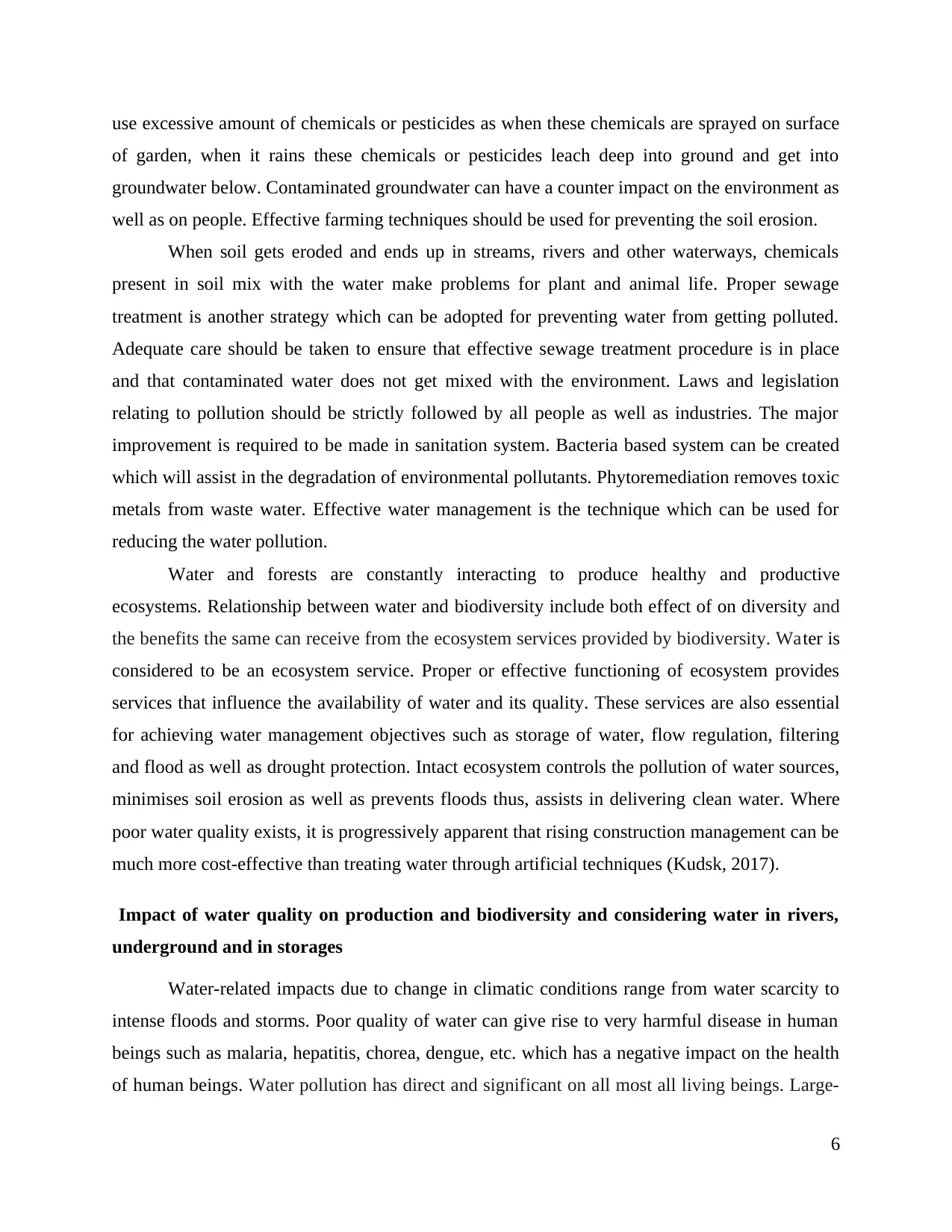
use excessive amount of chemicals or pesticides as when these chemicals are sprayed on surface
of garden, when it rains these chemicals or pesticides leach deep into ground and get into
groundwater below. Contaminated groundwater can have a counter impact on the environment as
well as on people. Effective farming techniques should be used for preventing the soil erosion.
When soil gets eroded and ends up in streams, rivers and other waterways, chemicals
present in soil mix with the water make problems for plant and animal life. Proper sewage
treatment is another strategy which can be adopted for preventing water from getting polluted.
Adequate care should be taken to ensure that effective sewage treatment procedure is in place
and that contaminated water does not get mixed with the environment. Laws and legislation
relating to pollution should be strictly followed by all people as well as industries. The major
improvement is required to be made in sanitation system. Bacteria based system can be created
which will assist in the degradation of environmental pollutants. Phytoremediation removes toxic
metals from waste water. Effective water management is the technique which can be used for
reducing the water pollution.
Water and forests are constantly interacting to produce healthy and productive
ecosystems. Relationship between water and biodiversity include both effect of on diversity and
the benefits the same can receive from the ecosystem services provided by biodiversity. Water is
considered to be an ecosystem service. Proper or effective functioning of ecosystem provides
services that influence the availability of water and its quality. These services are also essential
for achieving water management objectives such as storage of water, flow regulation, filtering
and flood as well as drought protection. Intact ecosystem controls the pollution of water sources,
minimises soil erosion as well as prevents floods thus, assists in delivering clean water. Where
poor water quality exists, it is progressively apparent that rising construction management can be
much more cost-effective than treating water through artificial techniques (Kudsk, 2017).
Impact of water quality on production and biodiversity and considering water in rivers,
underground and in storages
Water-related impacts due to change in climatic conditions range from water scarcity to
intense floods and storms. Poor quality of water can give rise to very harmful disease in human
beings such as malaria, hepatitis, chorea, dengue, etc. which has a negative impact on the health
of human beings. Water pollution has direct and significant on all most all living beings. Large‐
6
of garden, when it rains these chemicals or pesticides leach deep into ground and get into
groundwater below. Contaminated groundwater can have a counter impact on the environment as
well as on people. Effective farming techniques should be used for preventing the soil erosion.
When soil gets eroded and ends up in streams, rivers and other waterways, chemicals
present in soil mix with the water make problems for plant and animal life. Proper sewage
treatment is another strategy which can be adopted for preventing water from getting polluted.
Adequate care should be taken to ensure that effective sewage treatment procedure is in place
and that contaminated water does not get mixed with the environment. Laws and legislation
relating to pollution should be strictly followed by all people as well as industries. The major
improvement is required to be made in sanitation system. Bacteria based system can be created
which will assist in the degradation of environmental pollutants. Phytoremediation removes toxic
metals from waste water. Effective water management is the technique which can be used for
reducing the water pollution.
Water and forests are constantly interacting to produce healthy and productive
ecosystems. Relationship between water and biodiversity include both effect of on diversity and
the benefits the same can receive from the ecosystem services provided by biodiversity. Water is
considered to be an ecosystem service. Proper or effective functioning of ecosystem provides
services that influence the availability of water and its quality. These services are also essential
for achieving water management objectives such as storage of water, flow regulation, filtering
and flood as well as drought protection. Intact ecosystem controls the pollution of water sources,
minimises soil erosion as well as prevents floods thus, assists in delivering clean water. Where
poor water quality exists, it is progressively apparent that rising construction management can be
much more cost-effective than treating water through artificial techniques (Kudsk, 2017).
Impact of water quality on production and biodiversity and considering water in rivers,
underground and in storages
Water-related impacts due to change in climatic conditions range from water scarcity to
intense floods and storms. Poor quality of water can give rise to very harmful disease in human
beings such as malaria, hepatitis, chorea, dengue, etc. which has a negative impact on the health
of human beings. Water pollution has direct and significant on all most all living beings. Large‐
6
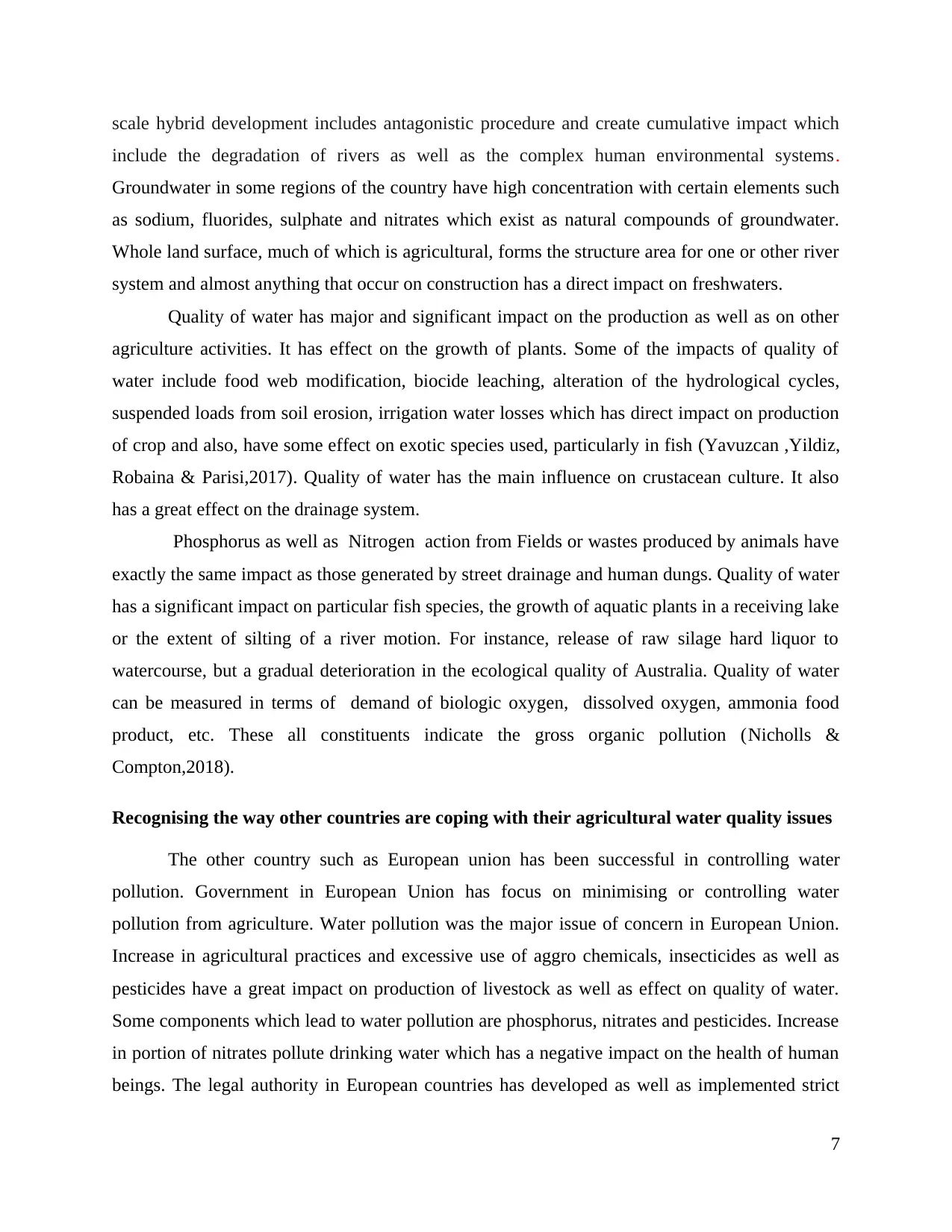
scale hybrid development includes antagonistic procedure and create cumulative impact which
include the degradation of rivers as well as the complex human environmental systems.
Groundwater in some regions of the country have high concentration with certain elements such
as sodium, fluorides, sulphate and nitrates which exist as natural compounds of groundwater.
Whole land surface, much of which is agricultural, forms the structure area for one or other river
system and almost anything that occur on construction has a direct impact on freshwaters.
Quality of water has major and significant impact on the production as well as on other
agriculture activities. It has effect on the growth of plants. Some of the impacts of quality of
water include food web modification, biocide leaching, alteration of the hydrological cycles,
suspended loads from soil erosion, irrigation water losses which has direct impact on production
of crop and also, have some effect on exotic species used, particularly in fish (Yavuzcan ,Yildiz,
Robaina & Parisi,2017). Quality of water has the main influence on crustacean culture. It also
has a great effect on the drainage system.
Phosphorus as well as Nitrogen action from Fields or wastes produced by animals have
exactly the same impact as those generated by street drainage and human dungs. Quality of water
has a significant impact on particular fish species, the growth of aquatic plants in a receiving lake
or the extent of silting of a river motion. For instance, release of raw silage hard liquor to
watercourse, but a gradual deterioration in the ecological quality of Australia. Quality of water
can be measured in terms of demand of biologic oxygen, dissolved oxygen, ammonia food
product, etc. These all constituents indicate the gross organic pollution (Nicholls &
Compton,2018).
Recognising the way other countries are coping with their agricultural water quality issues
The other country such as European union has been successful in controlling water
pollution. Government in European Union has focus on minimising or controlling water
pollution from agriculture. Water pollution was the major issue of concern in European Union.
Increase in agricultural practices and excessive use of aggro chemicals, insecticides as well as
pesticides have a great impact on production of livestock as well as effect on quality of water.
Some components which lead to water pollution are phosphorus, nitrates and pesticides. Increase
in portion of nitrates pollute drinking water which has a negative impact on the health of human
beings. The legal authority in European countries has developed as well as implemented strict
7
include the degradation of rivers as well as the complex human environmental systems.
Groundwater in some regions of the country have high concentration with certain elements such
as sodium, fluorides, sulphate and nitrates which exist as natural compounds of groundwater.
Whole land surface, much of which is agricultural, forms the structure area for one or other river
system and almost anything that occur on construction has a direct impact on freshwaters.
Quality of water has major and significant impact on the production as well as on other
agriculture activities. It has effect on the growth of plants. Some of the impacts of quality of
water include food web modification, biocide leaching, alteration of the hydrological cycles,
suspended loads from soil erosion, irrigation water losses which has direct impact on production
of crop and also, have some effect on exotic species used, particularly in fish (Yavuzcan ,Yildiz,
Robaina & Parisi,2017). Quality of water has the main influence on crustacean culture. It also
has a great effect on the drainage system.
Phosphorus as well as Nitrogen action from Fields or wastes produced by animals have
exactly the same impact as those generated by street drainage and human dungs. Quality of water
has a significant impact on particular fish species, the growth of aquatic plants in a receiving lake
or the extent of silting of a river motion. For instance, release of raw silage hard liquor to
watercourse, but a gradual deterioration in the ecological quality of Australia. Quality of water
can be measured in terms of demand of biologic oxygen, dissolved oxygen, ammonia food
product, etc. These all constituents indicate the gross organic pollution (Nicholls &
Compton,2018).
Recognising the way other countries are coping with their agricultural water quality issues
The other country such as European union has been successful in controlling water
pollution. Government in European Union has focus on minimising or controlling water
pollution from agriculture. Water pollution was the major issue of concern in European Union.
Increase in agricultural practices and excessive use of aggro chemicals, insecticides as well as
pesticides have a great impact on production of livestock as well as effect on quality of water.
Some components which lead to water pollution are phosphorus, nitrates and pesticides. Increase
in portion of nitrates pollute drinking water which has a negative impact on the health of human
beings. The legal authority in European countries has developed as well as implemented strict
7
⊘ This is a preview!⊘
Do you want full access?
Subscribe today to unlock all pages.

Trusted by 1+ million students worldwide
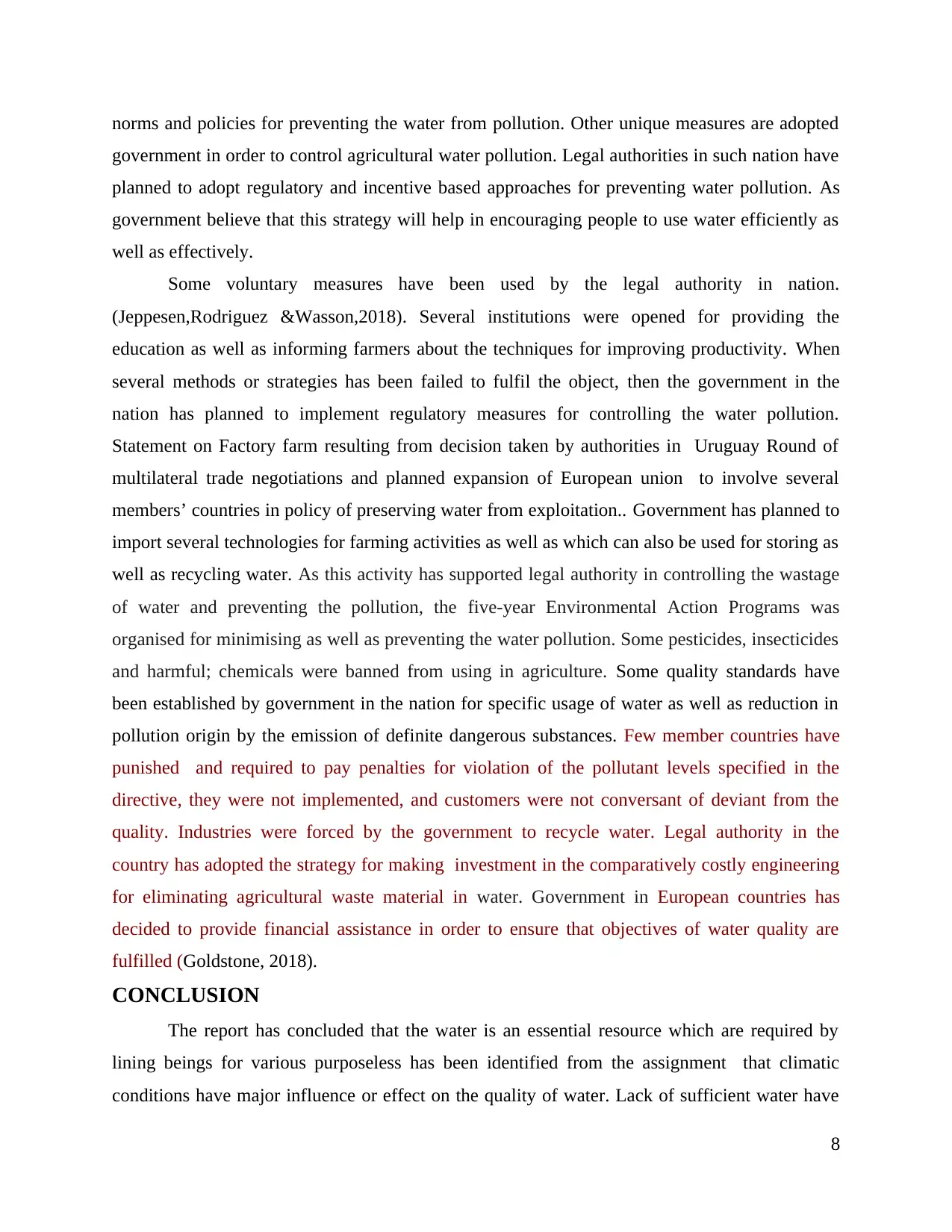
norms and policies for preventing the water from pollution. Other unique measures are adopted
government in order to control agricultural water pollution. Legal authorities in such nation have
planned to adopt regulatory and incentive based approaches for preventing water pollution. As
government believe that this strategy will help in encouraging people to use water efficiently as
well as effectively.
Some voluntary measures have been used by the legal authority in nation.
(Jeppesen,Rodriguez &Wasson,2018). Several institutions were opened for providing the
education as well as informing farmers about the techniques for improving productivity. When
several methods or strategies has been failed to fulfil the object, then the government in the
nation has planned to implement regulatory measures for controlling the water pollution.
Statement on Factory farm resulting from decision taken by authorities in Uruguay Round of
multilateral trade negotiations and planned expansion of European union to involve several
members’ countries in policy of preserving water from exploitation.. Government has planned to
import several technologies for farming activities as well as which can also be used for storing as
well as recycling water. As this activity has supported legal authority in controlling the wastage
of water and preventing the pollution, the five-year Environmental Action Programs was
organised for minimising as well as preventing the water pollution. Some pesticides, insecticides
and harmful; chemicals were banned from using in agriculture. Some quality standards have
been established by government in the nation for specific usage of water as well as reduction in
pollution origin by the emission of definite dangerous substances. Few member countries have
punished and required to pay penalties for violation of the pollutant levels specified in the
directive, they were not implemented, and customers were not conversant of deviant from the
quality. Industries were forced by the government to recycle water. Legal authority in the
country has adopted the strategy for making investment in the comparatively costly engineering
for eliminating agricultural waste material in water. Government in European countries has
decided to provide financial assistance in order to ensure that objectives of water quality are
fulfilled (Goldstone, 2018).
CONCLUSION
The report has concluded that the water is an essential resource which are required by
lining beings for various purposeless has been identified from the assignment that climatic
conditions have major influence or effect on the quality of water. Lack of sufficient water have
8
government in order to control agricultural water pollution. Legal authorities in such nation have
planned to adopt regulatory and incentive based approaches for preventing water pollution. As
government believe that this strategy will help in encouraging people to use water efficiently as
well as effectively.
Some voluntary measures have been used by the legal authority in nation.
(Jeppesen,Rodriguez &Wasson,2018). Several institutions were opened for providing the
education as well as informing farmers about the techniques for improving productivity. When
several methods or strategies has been failed to fulfil the object, then the government in the
nation has planned to implement regulatory measures for controlling the water pollution.
Statement on Factory farm resulting from decision taken by authorities in Uruguay Round of
multilateral trade negotiations and planned expansion of European union to involve several
members’ countries in policy of preserving water from exploitation.. Government has planned to
import several technologies for farming activities as well as which can also be used for storing as
well as recycling water. As this activity has supported legal authority in controlling the wastage
of water and preventing the pollution, the five-year Environmental Action Programs was
organised for minimising as well as preventing the water pollution. Some pesticides, insecticides
and harmful; chemicals were banned from using in agriculture. Some quality standards have
been established by government in the nation for specific usage of water as well as reduction in
pollution origin by the emission of definite dangerous substances. Few member countries have
punished and required to pay penalties for violation of the pollutant levels specified in the
directive, they were not implemented, and customers were not conversant of deviant from the
quality. Industries were forced by the government to recycle water. Legal authority in the
country has adopted the strategy for making investment in the comparatively costly engineering
for eliminating agricultural waste material in water. Government in European countries has
decided to provide financial assistance in order to ensure that objectives of water quality are
fulfilled (Goldstone, 2018).
CONCLUSION
The report has concluded that the water is an essential resource which are required by
lining beings for various purposeless has been identified from the assignment that climatic
conditions have major influence or effect on the quality of water. Lack of sufficient water have
8
Paraphrase This Document
Need a fresh take? Get an instant paraphrase of this document with our AI Paraphraser
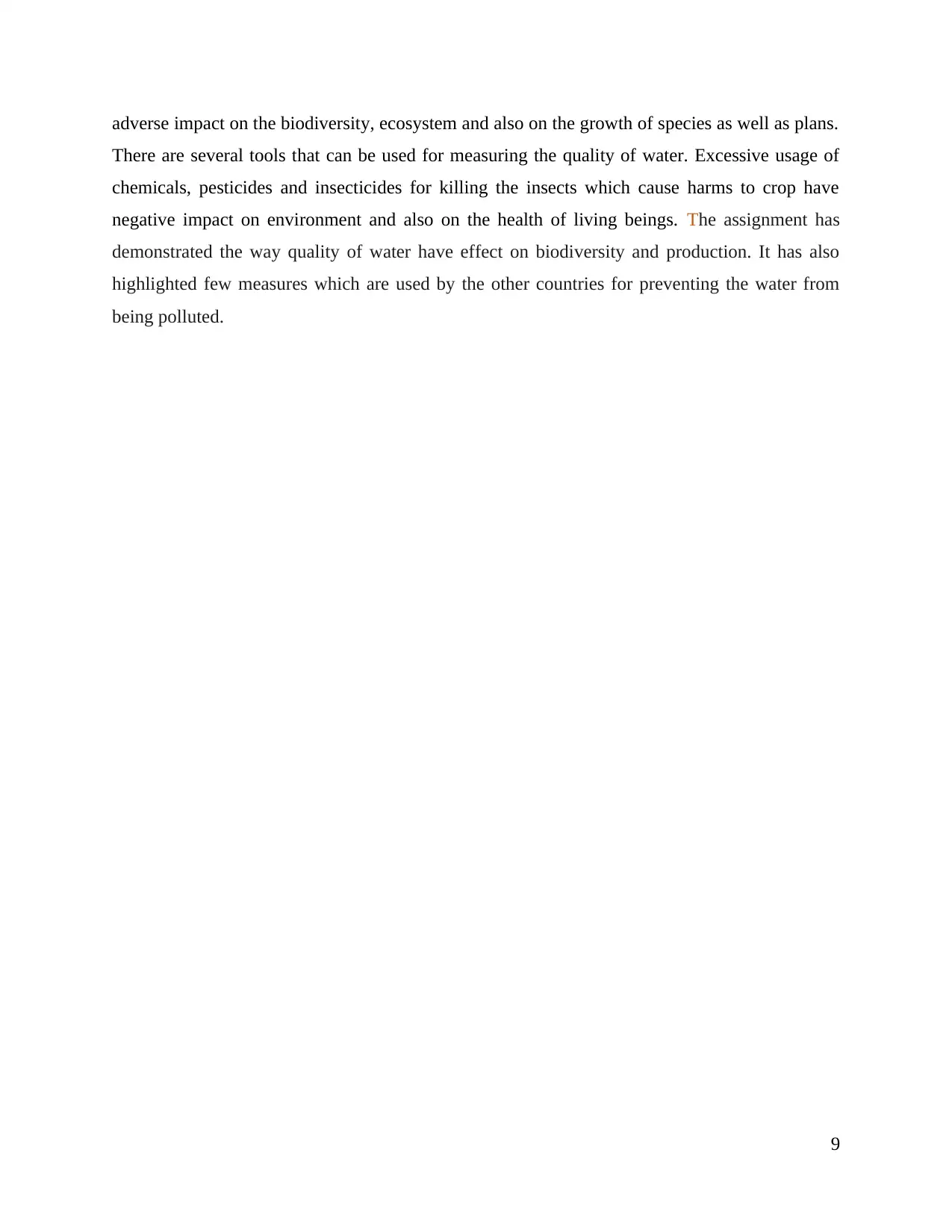
adverse impact on the biodiversity, ecosystem and also on the growth of species as well as plans.
There are several tools that can be used for measuring the quality of water. Excessive usage of
chemicals, pesticides and insecticides for killing the insects which cause harms to crop have
negative impact on environment and also on the health of living beings. The assignment has
demonstrated the way quality of water have effect on biodiversity and production. It has also
highlighted few measures which are used by the other countries for preventing the water from
being polluted.
9
There are several tools that can be used for measuring the quality of water. Excessive usage of
chemicals, pesticides and insecticides for killing the insects which cause harms to crop have
negative impact on environment and also on the health of living beings. The assignment has
demonstrated the way quality of water have effect on biodiversity and production. It has also
highlighted few measures which are used by the other countries for preventing the water from
being polluted.
9
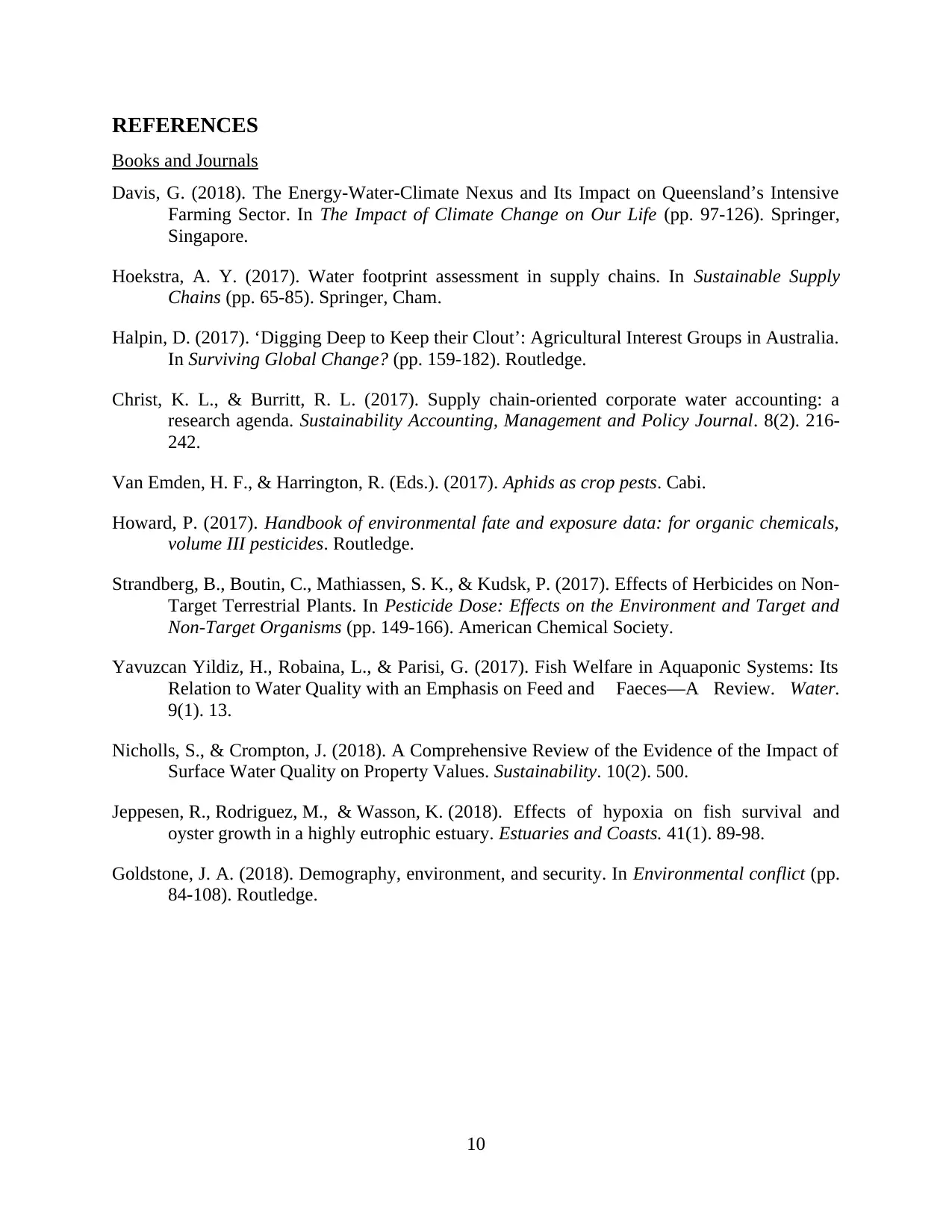
REFERENCES
Books and Journals
Davis, G. (2018). The Energy-Water-Climate Nexus and Its Impact on Queensland’s Intensive
Farming Sector. In The Impact of Climate Change on Our Life (pp. 97-126). Springer,
Singapore.
Hoekstra, A. Y. (2017). Water footprint assessment in supply chains. In Sustainable Supply
Chains (pp. 65-85). Springer, Cham.
Halpin, D. (2017). ‘Digging Deep to Keep their Clout’: Agricultural Interest Groups in Australia.
In Surviving Global Change? (pp. 159-182). Routledge.
Christ, K. L., & Burritt, R. L. (2017). Supply chain-oriented corporate water accounting: a
research agenda. Sustainability Accounting, Management and Policy Journal. 8(2). 216-
242.
Van Emden, H. F., & Harrington, R. (Eds.). (2017). Aphids as crop pests. Cabi.
Howard, P. (2017). Handbook of environmental fate and exposure data: for organic chemicals,
volume III pesticides. Routledge.
Strandberg, B., Boutin, C., Mathiassen, S. K., & Kudsk, P. (2017). Effects of Herbicides on Non-
Target Terrestrial Plants. In Pesticide Dose: Effects on the Environment and Target and
Non-Target Organisms (pp. 149-166). American Chemical Society.
Yavuzcan Yildiz, H., Robaina, L., & Parisi, G. (2017). Fish Welfare in Aquaponic Systems: Its
Relation to Water Quality with an Emphasis on Feed and Faeces—A Review. Water.
9(1). 13.
Nicholls, S., & Crompton, J. (2018). A Comprehensive Review of the Evidence of the Impact of
Surface Water Quality on Property Values. Sustainability. 10(2). 500.
Jeppesen, R., Rodriguez, M., & Wasson, K. (2018). Effects of hypoxia on fish survival and
oyster growth in a highly eutrophic estuary. Estuaries and Coasts. 41(1). 89-98.
Goldstone, J. A. (2018). Demography, environment, and security. In Environmental conflict (pp.
84-108). Routledge.
10
Books and Journals
Davis, G. (2018). The Energy-Water-Climate Nexus and Its Impact on Queensland’s Intensive
Farming Sector. In The Impact of Climate Change on Our Life (pp. 97-126). Springer,
Singapore.
Hoekstra, A. Y. (2017). Water footprint assessment in supply chains. In Sustainable Supply
Chains (pp. 65-85). Springer, Cham.
Halpin, D. (2017). ‘Digging Deep to Keep their Clout’: Agricultural Interest Groups in Australia.
In Surviving Global Change? (pp. 159-182). Routledge.
Christ, K. L., & Burritt, R. L. (2017). Supply chain-oriented corporate water accounting: a
research agenda. Sustainability Accounting, Management and Policy Journal. 8(2). 216-
242.
Van Emden, H. F., & Harrington, R. (Eds.). (2017). Aphids as crop pests. Cabi.
Howard, P. (2017). Handbook of environmental fate and exposure data: for organic chemicals,
volume III pesticides. Routledge.
Strandberg, B., Boutin, C., Mathiassen, S. K., & Kudsk, P. (2017). Effects of Herbicides on Non-
Target Terrestrial Plants. In Pesticide Dose: Effects on the Environment and Target and
Non-Target Organisms (pp. 149-166). American Chemical Society.
Yavuzcan Yildiz, H., Robaina, L., & Parisi, G. (2017). Fish Welfare in Aquaponic Systems: Its
Relation to Water Quality with an Emphasis on Feed and Faeces—A Review. Water.
9(1). 13.
Nicholls, S., & Crompton, J. (2018). A Comprehensive Review of the Evidence of the Impact of
Surface Water Quality on Property Values. Sustainability. 10(2). 500.
Jeppesen, R., Rodriguez, M., & Wasson, K. (2018). Effects of hypoxia on fish survival and
oyster growth in a highly eutrophic estuary. Estuaries and Coasts. 41(1). 89-98.
Goldstone, J. A. (2018). Demography, environment, and security. In Environmental conflict (pp.
84-108). Routledge.
10
⊘ This is a preview!⊘
Do you want full access?
Subscribe today to unlock all pages.

Trusted by 1+ million students worldwide
1 out of 14
Related Documents
Your All-in-One AI-Powered Toolkit for Academic Success.
+13062052269
info@desklib.com
Available 24*7 on WhatsApp / Email
![[object Object]](/_next/static/media/star-bottom.7253800d.svg)
Unlock your academic potential
Copyright © 2020–2025 A2Z Services. All Rights Reserved. Developed and managed by ZUCOL.





